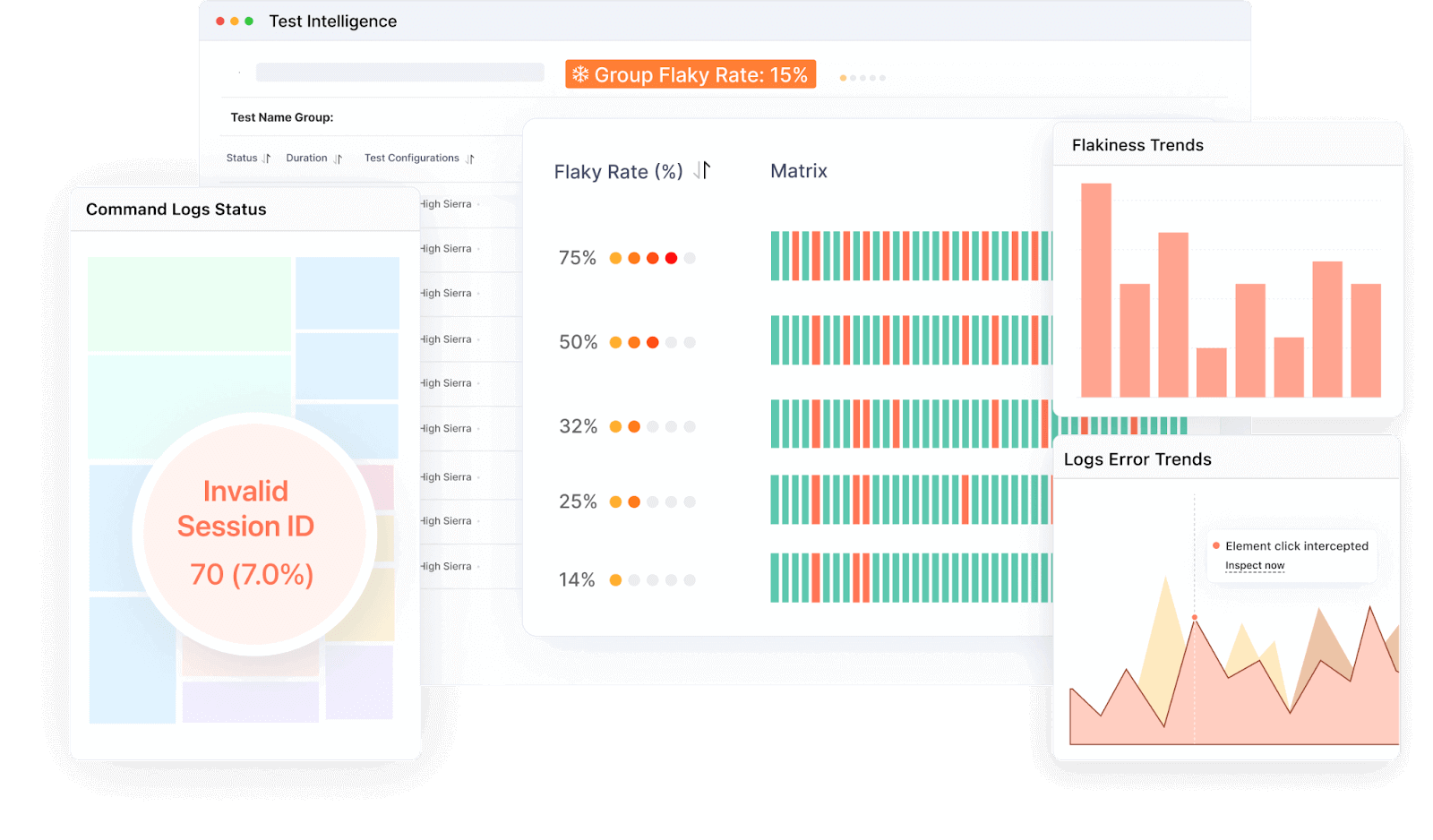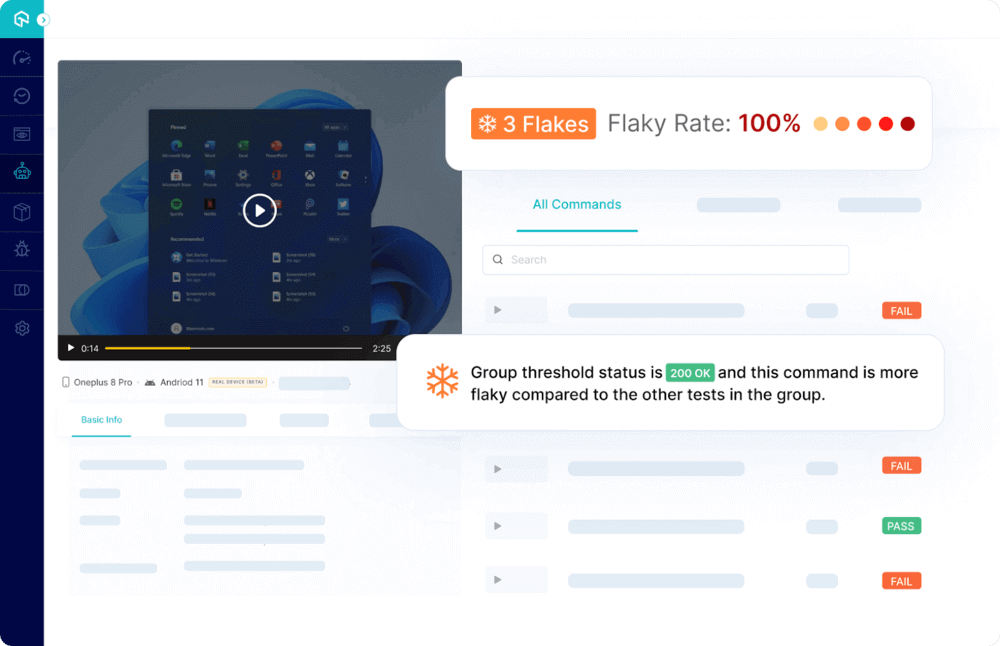OVERVIEW
Flaky tests are a common challenge faced by software developers and testers during the software development lifecycle. Flaky tests refer to tests that produce inconsistent results, passing or failing unpredictably, without any changes to the code under test. These tests can be frustrating and time-consuming as they lead to decreased productivity and unreliable test results.
In this tutorial, we will delve into the concept of flaky tests, exploring their causes, detection techniques, and effective solutions to mitigate their impact. By understanding the intricacies of flaky tests and equipping ourselves with the knowledge to tackle them head-on, you can ensure the reliability and accuracy of our test suites, leading to more efficient software development processes.
What are Flaky Tests?
A flaky test, in software testing, is an automated test that demonstrates inconsistent behavior by producing varying outcomes when executed multiple times on the same functionality. These tests are characterized by their unpredictability, as they may pass or fail intermittently without any changes in the code or the application being tested.
Flaky tests can be a challenge for software developers and testers as they make it difficult to determine whether a failure is due to a genuine bug or a result of the test's instability. The unreliability of flaky tests can hinder the testing process, leading to wasted time, effort, and reduced confidence in the accuracy of the testing outcomes.
What are the causes of Flaky Tests?
Flaky tests, which exhibit inconsistent behavior and produce varying results, can be attributed to a variety of underlying factors. Understanding these causes is crucial for effectively addressing flakiness and improving the reliability of automated testing. By identifying and addressing the root causes, software development teams can mitigate the impact of flaky tests and achieve more dependable testing outcomes. Below is a list of factors that cause Flaky Tests.
- Environmental Factors: Flaky tests can be caused by environmental factors such as fluctuations in system resources (CPU, memory), network connectivity issues, or dependencies on external services and APIs.
- Timing and Synchronization Issues: Timing and synchronization issues, such as race conditions, unstable application states, or unpredictable delays, can introduce flakiness into tests.
- Test Dependencies: Flaky tests can arise from dependencies between tests, shared resources, or data contamination caused by improper test isolation.
- Inconsistent Test Data: Flaky tests can occur when test data is inconsistent or changes during test execution due to dynamic data sources, external data dependencies, or data modification within tests.
- Non-deterministic Application Behavior: Non-deterministic application behavior, such as asynchronous operations, randomness, or concurrent processes/threads, can lead to flaky tests.
How to detect Flaky Tests?
Detecting flaky tests is a critical aspect of ensuring the reliability and effectiveness of automated testing. Flaky tests, which produce inconsistent results across multiple test runs, can be challenging to identify and address. However, by employing effective detection techniques, software development teams can gain insights into the stability of their tests and take appropriate measures to improve the overall test execution process. Detecting flaky tests involves the use of various strategies and tools to identify patterns of inconsistency and unreliability. Here’s a list of those tools and strategies:
- Statistical Analysis: Analyzing historical test results, identifying failure patterns, and calculating the probability of flakiness can detect flaky tests. Statistical methods help identify patterns and anomalies in test data, providing insights for further investigation and resolution.
- Test Reruns and Variability: Running tests multiple times and analyzing result variations can indicate flakiness. Inconsistent outcomes across runs suggest potential flakiness. Observing variability helps pinpoint unreliable tests and take appropriate action.
- Custom Test Annotations: Using annotations or markers to flag and track flaky behavior aids detection. Custom annotations specifically designed for flaky tests allow easy tracking and monitoring over time, revealing trends and patterns.
- Continuous Integration Tools: Leveraging Continuous Integration tools with built-in flaky test detection simplifies the process. Automatic analysis identifies tests with inconsistent behavior. Integration with version control and reporting enables efficient identification and resolution of flaky tests.
- Active Monitoring and Reporting: Continuous monitoring and comprehensive reports help identify and track flaky tests. Monitoring test runs and recording metrics like failure rates detects flakiness proactively. Detailed reports offer insights into test suite stability and reliability.
What are the Strategies to Reduce Flakiness?
Flakiness in automated tests can be a significant hurdle in achieving reliable and consistent testing outcomes. To mitigate the impact of flaky tests and improve the stability of automated testing, it is essential to implement effective strategies. These strategies target the underlying causes of flakiness and help ensure more dependable and accurate test results. Reducing flakiness requires a combination of proactive measures and best practices. Here’s a list of strategies that help reduce flakiness:
- Test Isolation: Isolating tests from external dependencies and other tests can help reduce flakiness. By running tests in isolation, without interference from external factors, the likelihood of flakiness decreases. It promotes consistent and reliable test execution.
- Clearing Test Dependencies: Ensuring proper cleanup of test dependencies and resources after each test execution can prevent interference between tests. By removing any residual state or dependencies, tests start with a clean slate, minimizing the chances of flakiness due to leftover artifacts.
- Stabilizing the Environment: Stabilizing the test environment by addressing environmental factors and minimizing fluctuations can improve test reliability. This includes factors such as network stability, server load, or system configurations. A stable and controlled environment reduces the chances of flakiness caused by external influences.
- Consistent Test Data Generation: Using consistent and reproducible test data generation techniques, such as using fixed data sets or mock data, can help reduce flakiness. When tests rely on predictable and consistent data, they are less likely to produce inconsistent results and exhibit flakiness.
- Synchronization Techniques: Applying synchronization techniques, like explicit waits and timeouts, can address timing and synchronization issues that lead to flakiness. By synchronizing test steps with the application under test, tests can wait for desired conditions before proceeding, reducing the chances of flakiness caused by timing mismatches.
- Employ Test Retry Mechanisms: Introducing retry mechanisms in tests to rerun flaky test cases can help ensure accurate and consistent results. By retrying the test a certain number of times, intermittent issues causing flakiness may resolve, leading to more reliable outcomes.

How to Maintain a Flaky Test-Free Test Suite?
Having a reliable and stable test suite is crucial for ensuring accurate and dependable test results. Flaky tests can undermine the effectiveness of the testing process, leading to wasted time, unreliable outcomes, and reduced confidence in the software being tested. To mitigate the impact of flakiness and maintain a flaky test-free test suite, it is essential to establish proactive maintenance practices and implement effective strategies.
- Regular Test Maintenance: Conduct regular test maintenance activities, such as reviewing and updating tests, removing redundant tests, and resolving flakiness issues. By regularly maintaining tests, teams can ensure that tests remain relevant, reliable, and free from flakiness, leading to more accurate and actionable results.
- Continuous Monitoring: Implement a system for continuous monitoring of test execution and results to promptly identify and address flaky tests. By continuously monitoring test runs and analyzing results in real-time, teams can quickly detect flakiness and take immediate corrective actions, reducing its impact on the testing process.
- Collaboration with Team Members: Foster collaboration between developers, testers, and other team members to collectively address and resolve flaky test issues. By encouraging open communication and collaboration, teams can share insights, leverage diverse perspectives, and collectively work towards identifying the root causes of flakiness and implementing effective solutions.
- Collecting and Analyzing Test Metrics: Collect and analyze relevant test metrics, such as test execution times, failure rates, and flakiness patterns, to gain insights and make data-driven decisions. By tracking and analyzing test metrics, teams can identify trends, patterns, and correlations that provide valuable insights into the nature and extent of flakiness, enabling targeted efforts for improvement.
- Test Case Prioritization: Prioritize test cases based on their criticality and impact on the system under test. By prioritizing tests, teams can allocate more resources and attention to critical tests, ensuring that they receive thorough testing and addressing any flakiness issues that may arise.
Leveraging LambdaTest’s AI-Powered Test Intelligence
LambdaTest's Test Intelligence is designed to reduce flaky tests and enhance test stability. Here are some key features offered by LambdaTest's AI-Powered Test Intelligence Platform that can help in addressing flaky tests:

- Intelligent Flakiness Detection: LambdaTest's Test Intelligence uses machine learning algorithms to analyze test execution data and identify flaky tests, prioritizing efforts for resolution.
- Error Classification of Log Trends: Test Intelligence analyzes test logs, classifies errors based on trends, and helps identify recurring issues contributing to flakiness.
- Command Logs Error Trends Forecast: Test Intelligence forecasts error trends by analyzing command logs, providing proactive recommendations to prevent or resolve issues affecting test reliability.
- Anomalies in Test Execution across Platforms: Test Intelligence detects anomalies in test execution across platforms, helping teams prioritize efforts to improve stability for specific environments.

These features provided by LambdaTest's Test Intelligence empower teams to take data-driven actions in identifying, resolving, and preventing flaky tests. By leveraging machine learning and intelligent analysis, LambdaTest aims to enhance the reliability and effectiveness of automated testing, resulting in more robust software delivery.
Conclusion
Flaky tests can be a major hurdle in the software development process, but armed with knowledge and the right strategies, they can be effectively managed and minimized. By understanding the causes, implementing detection techniques, and adopting best practices for writing flakiness-resistant tests, developers and testers can ensure the reliability and accuracy of their test suites. Remember, regular maintenance and collaboration with team members are key to maintaining a flaky test-free environment.
By implementing various techniques, software development teams can overcome the challenges posed by flaky tests and create a smoother and more efficient development experience. It is an ongoing journey that requires diligence, proactive measures, and collaboration, but the rewards of a reliable and robust test suite are well worth the effort.
 Christmas Deal is on: Save 25% off on select annual plans for 1st year.
Christmas Deal is on: Save 25% off on select annual plans for 1st year.












